
Vicia sativa, known as the common vetch, garden vetch, tare or simply vetch, is a nitrogen-fixing leguminous plant in the family Fabaceae. It is now naturalised throughout the world occurring on every continent, except Antarctica and the Arctic. The centre of diversity is thought to be the Fertile Crescent, although gold standard molecular confirmation is currently not available.

Vicia cracca, is a species of flowering plant in the pea and bean family Fabaceae. It is native to Europe and Asia. It occurs on other continents as an introduced species, including North America, where it is a common weed. It often occurs in disturbed habitats, including old fields and roadside ditches.

Vicia hirsuta is a species of flowering plant in the pea and bean family Fabaceae.

Vicia tetrasperma the smooth tare, smooth vetch, lentil vetch or sparrow vetch, is a species of flowering plant in the bean family Fabaceae.
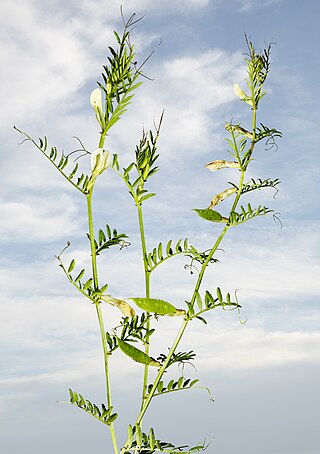
Vicia lutea is a species of flowering plant in the bean family Fabaceae.

Vicia lathyroides is a plant species in the bean family Fabaceae. It is native to Europe and western Asia, and it is known on other continents as an introduced species. It is an annual herb with pealike blue- or purple-tinged flowers about half a centimeter wide and hairless legume pods up to 3 centimeters long.

Vicia americana is a species of legume in the vetch genus known by the common names American vetch and purple vetch. It includes a subspecies known as mat vetch.

Abronia turbinata is a species of flowering plant in the four o'clock family known by the common name transmontane sand-verbena. It is native to eastern California and Oregon and western Nevada, where it grows in desert and plateau scrub.

Astragalus asymmetricus is a species of milkvetch known by the common name San Joaquin milkvetch. It is endemic to California, where it grows in grassy and disturbed areas in the Central Valley and nearby parts of the Central Coast Ranges and San Francisco Bay Area.
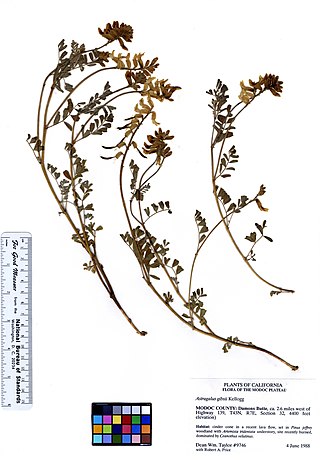
Astragalus gibbsii is a species of milkvetch known by the common name Gibbs's milkvetch. It is native to eastern California, the north-central Sierra Nevada, and western Nevada, where it grows in the pine forest habitat of the mountains and the sagebrush of the plateaus.
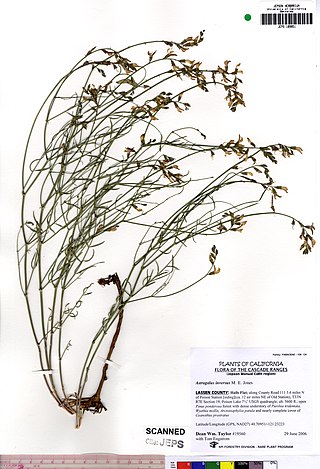
Astragalus inversus is a species of milkvetch known by the common name Susanville milkvetch.

Astragalus oxyphysus is a species of milkvetch known by the common name Mt. Diablo milkvetch or Stanislaus milk-vetch. It is endemic to central California, where it grows in dry grassland and scrub habitat in the Central Valley and the adjacent Inner Coast Ranges and Sierra Nevada foothills.

Astragalus pycnostachyus is a species of milkvetch known by the common name marsh milkvetch. It is endemic to the coastline of California, where it grows in wet saline habitat such as marshes.
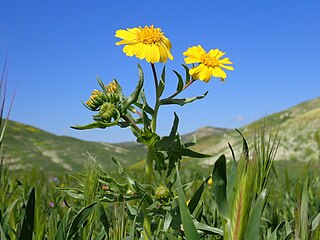
Madia radiata is a species of flowering plant in the family Asteraceae known by the common names golden madia and showy madia. It is endemic to California, where it is known mostly from the Central Coast Ranges and adjacent edges of the San Francisco Bay Area and Central Valley.
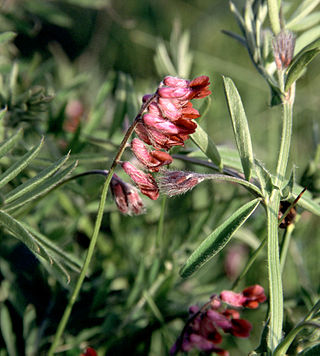
Vicia benghalensis is a species of vetch known by the common names purple vetch and reddish tufted vetch. It is native to southern Europe, North Africa, and nearby islands, and it is utilized elsewhere in agriculture and may be present in the wild as an introduced species. It is an annual herb with a climbing stem which is coated in hairs, often densely, making the plant appear silvery white. Each leaf is made up of several pairs of elongated leaflets which measure up to 3 centimeters in length. The inflorescence is a one-side raceme of several dark reddish purple flowers. Each flower has a densely hairy calyx of sepals and a tubular corolla between one and two centimeters in length. The fruit is a flat, hairy legume pod up to 3.5 centimeters long containing multiple seeds.

Vicia nigricans is a species of vetch known by the common name black vetch. It has a disjunct distribution, its two subspecies divided by thousands of miles in range. The northern subspecies, ssp. gigantea, is native to western North America from Alaska to northern California, where it occurs in coastal and moist inland habitat and disturbed areas. The southern subspecies, ssp. nigricans, occurs in southern South America, in Argentina and Chile.

Vicia pannonica is a species of vetch known by the common name Hungarian vetch. It is native to southern, central Europe and western Asia, and it is sometimes cultivated as an agricultural crop for use as hay and fodder. It may escape cultivation and grow as a casual roadside weed.

Wyethia angustifolia is a species of flowering plant in the family Asteraceae known by the common names California compassplant and narrowleaf mule's ears. It is native to the west coast of the United States from Washington to California, where it grows in grassland, meadows, and other open habitat. It is a perennial herb growing from a tough taproot and caudex unit and producing a stem 30 to 90 centimeters tall. The leaves have lance-shaped blades up to 50 centimeters tall. The inflorescence produces one or more large sunflower-like flower heads at the top of the hairy stem. The head has narrow, hairy phyllaries at the base. It contains up to 21 yellow ray florets each up to 4.5 centimeters long and many yellow disc florets. The fruit is an achene which may be nearly 2 centimeters long including its pappus.

Astragalus desereticus is a rare species of milkvetch known by the common name Deseret milkvetch. It is endemic to Utah County, Utah, where it is known from only one population. It was thought to be extinct until 1981 when this population was discovered. The population contains 5,000 to 10,000 plants on an area of land covering less than 300 acres. It is vulnerable to damage from grazing cattle, which eat the plant and trample the soil, and from development and erosion. This is a federally listed threatened species.
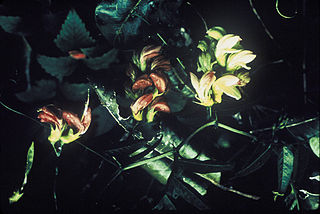
Vicia menziesii is a rare species of flowering plant in the legume family known by the common name Hawaiian vetch. It is endemic to Hawaii, where it is known only from the island of Hawaii. It is threatened by habitat loss and exotic plants. It has been federally listed as an endangered species of the United States since 1978. It was the first Hawaiian plant to be placed on the Endangered Species List.





















